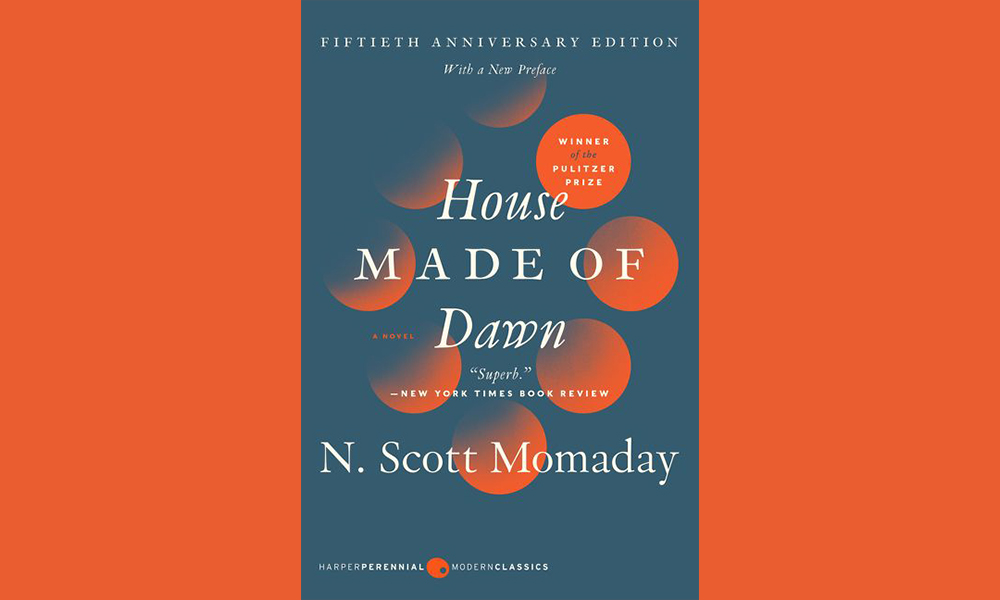In 1969, N. Scott Momaday’s House Made of Dawn won the Pulitzer Prize for Fiction, helping usher in the Native American Renaissance. It was his first novel and second published book, after the folkloric The Journey of Tai-me (1967). The novel’s publication launched him into the public sphere.
Momaday has since gone on to have a glittering career, with countless awards and honorary degrees, making great strides in establishing the university field of Indian Studies, and extending American literature overseas, most notably into Russia. I first came across Momaday’s work when I was living in New York and watched Ken Burns’ documentary The West. In the film, Momaday spoke with such an authoritative voice and unique perspective that I felt compelled to seek out his writing. I want to reflect on House Made of Dawn and how it can help us understand our current linguistic paradoxes. To my mind, it remains essential reading for understanding the political and cultural paradigms of the American West and settler colonies more generally.
House Made of Dawn focuses on the lives of individuals, their place in a wider community, and, in one way of telling, about how to narrate a modern experience for Indigenous people. The novel tells the story of being inside and outside two worlds that share the same location, that often run in parallel, but sometimes against one another. Although magical realism emerged around the same time as Momaday’s novel, Momaday presents a different narrative path than the “magical realism” that was projected onto every work from outside the West after the Latin American magical realist boom of Gabriel Garcia Marquez et al. This rather flat sense of magical realism is still often applied to writers as diverse as Ben Okri, Alexis Wright, and Salman Rushdie. Momaday’s style, however, paved a different path entirely.
House Made of Dawn is a work of worldly literature, and an opportunity to think through more creative forms of the novel today. Not only is there a whole Kiowa world that informs his novel, but also a distinct literary style, an indigenous politics, and a spiritual consciousness — we might call his style Momadayan. Momadayan is syncretic, connected, rich. It thinks through deep time and linguistic history. House Made of Dawn is the work of an individual who speaks not only on behalf of, but with other people.
Momaday and House Made of Dawn seem somewhat different to Chinua Achebe’s perspective in “The African Writer and the English Language.” In that essay, Achebe argues that the literature he promotes is “a new English, still in full communion with its ancestral home [of England] but altered to suit its new African surroundings.” Around the same time, Ngugi wa Thiong’o proposed something like the opposite, turning away from English to write in Gikuyu, his ancestral tongue. The debate over the appropriate language of cultural production seemed to fall between ideas of Achebean assimilation and Thiong’oan self-determination.
And yet, this binary is not quite right when I read Momaday and think through the implications of his work. The choice is not between having an African — or Indigenous — cultural position within a colonial language versus a wholly separate realm of cultural production in a native, non-colonial tongue. Society does both while also working towards a new social contract and a type of multilingualism that is porous. It is not a choice between English and Gikuyu. Instead, it is how we move towards multilingualism as a thought process and a social characteristic. This multilingualism is not simply in the way “hybridity” of an earlier postcolonial moment suggests. For instance, we must place greater emphasis on the role of translators. The earlier debate privileged the author function and reified the individual. It forgot how collaborative making a novel actually is. It even forgot the reader. Instead, we need to see the collective labor of a universal language and how it is materialized in systems we might call “English” or “Gikuyu” for ease of purpose.
In recognizing that the Achebe–Thiong’o choice is not adequate for settler societies today, we might then argue for the recognition of an Indigenous cosmopolitanism that sees the true dynamism of daily life. This is where people speak more than one tongue, historically and into today. For example, in the Western Pilbara people have spoken seven or eight daily languages and are versed in a number of ceremonial ones. Some people still continue these lingual practices today. A familiar template might be seen in France, where Catholic mass is sometimes performed in Latin, but churchgoers use French in their daily lives, in addition to being familiar with Italian, Catalan, and probably one or two other tongues besides. And yet, what is distinct today is that efforts to maintain smaller language groups are negligible, and cultural output in them is not highly valued. It means arguing for art and poetry and culture and song and literature as opposed to warships and missiles and tanks. It gives everyone in settler societies the possibilities of being responsible, for endangered languages, for literature as a whole, for crafting multiple identities. This is the vision Momaday lays out.
Momaday reinforces that his language’s ancestral home is rooted in the deep ecology and ancient language of Kiowa country. In House Made of Dawn, English allows Indigenous people to communicate with others in a trade language of a particular historical moment. His story, however, is all about the language underneath the language, even though we only have the language that sits on top. Reading Momaday’s work is to sense the aquifer beneath the ground when we see the surface of the river before us. This means accepting that the language world is deep and multilayered, and Indigenous languages matter to the universal experience of humanity. That is what it is to be Momadayan where we currently belong.


